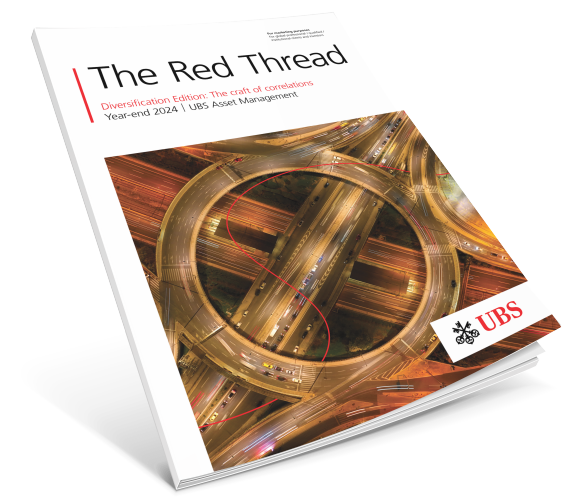The Red Thread
The beauty of indexing
Alleviating concentration in cap weighted indices via other indexing techniques

![]()
header.search.error
The Red Thread
Alleviating concentration in cap weighted indices via other indexing techniques

With the increasing concentration of many equity markets, Boriana Iordanova explains how rules-based techniques can help offer more effective portfolio diversification than traditional market cap weighted indexes.
One of the topics from my financial economics undergraduate classes that has stayed vividly in my memory is the importance of portfolio diversification. Buy a stock in a company that makes umbrellas and a stock in a company that makes ice cream, our tutor told us – the former would tend to do well in autumn/winter, the latter – in spring/summer, helping your portfolio achieve steady returns over the year (unless you live in the UK, in which case an umbrella comes in handy all year-round!)
Despite its oversimplified nature, the idea of the ‘umbrella-ice cream’ portfolio is a sensible diversification strategy, and one of the reasons investors are drawn to indexing: holding a ‘slice of the market’ should, in theory, be the ultimate diversifier.
Over the past several years, though, the global ‘market slice’ has become increasingly Technology heavy, US-oriented, and concentrated in a handful of stocks (Figure 1), prompting index investors to seek other routes of gaining global market exposure, but without the high concentration currently exhibited by cap weighted indexes. There are a number of rules-based approaches designed to achieve that, and in this article we outline some of these and discuss their practical application. Investors should be mindful that some of these approaches could at times result in significant underperformance vs. cap weighted indexes – hence, a combination of diversification strategies might be more optimal compared to exposure to just one.
Figure 1: ‘Triple trouble’: global equity market cap weighted indices are highly concentrated at present on stock, sector, and country level
top 10 stocks aggregate index weight – equivalent to the bottom 1063 stocks
index weight in IT and Communication Services stocks
index weight in 1 country, US, 28% in 22 other countries
Before we describe these approaches, it is worth noting that concentration in equity indexes, and the solutions to alleviate it, is nothing new.
The first equity index, the Dow Jones Railroad Average, constructed in 1884, comprised 11 stocks, 9 of which were railroads (the other two were a sea shipping stock and a telegraph stock). And if you thought concentration could not possibly get worse than that, think again: if equity indexes existed in the 1630s, they would have likely been even more concentrated – in tulip bulb stocks.
In more recent times, at the end of the 1990s, before the ‘dot.com’ bubble burst, the aggregate weight of Technology and Communication Services in global market cap indexes was the same as it is now, representing more than a third of the total index weight, and at the end of 2006, the year before the start of the Global Financial Crisis, Financials represented more than a quarter of the total global index weight.
Many of the historic instances of high index concentration self-corrected following a market crash. Index providers subsequently thought of diversification solutions, which attracted attention in the aftermath of the market correction (Figure 2), but as new investment themes emerged, and the next bull market gained momentum, these diversification strategies took backstage, until the next correction/crash, and so on, history has been repeating itself…
- | - | - | - | New index technique introduced | New index technique introduced | New index technique introduced | New index technique introduced |
|---|---|---|---|---|---|---|---|
- | Event | - | Cap weighted indexes flaw evident during the event | New index technique introduced | Overview | New index technique introduced | Relative performance vs. cap weighted indexes: highlights |
- | Late 1990s – early 2000s ‘dot.com’ bubble | - | Increasing index weight of overvalued and unprofitable internet and communications stocks | New index technique introduced | Fundamental indices: stock selection and/or stock weighting detached from price, and based on company fundamentals instead | New index technique introduced | 2000-2022: +11% p.a. on average. 2009: +7%, benefitting from Financials overweight, as markets rallied following the GFC 2022: +13%, benefitting from Energy overweight, amidst Russia’s invasion of Ukraine |
- | 2007 – 2008 Global Financial Crisis (GFC) | - | Extreme price volatility | New index technique introduced | Low volatility and minimum variance indexes: stock selection and/or weighting based on price volatility and/or correlations | New index technique introduced | Between 2000 and 2023, there have been 8 years when cap weighted indexes recorded negative returns (in USD): Min Vol indexes outperformed market cap by 11% p.a. on average during these years, including +18% in 2008 |
- | 2010 – 2012 European sovereign debt crisis | - | High volatility in Financials, the largest sector in cap weighted indexes at the time, spread to other sectors | New index technique introduced | Quality indices: select and/or overweight profitable companies with durable business models, stable earnings, and low leverage – viewed as ‘defensive’ and ‘safe havens’ | New index technique introduced | Similar to low vol, quality outperformed market cap in the 8 ‘down’ years between 2000 and 2023 (+4% p.a. on average), but also outperformed by 1% p.a. on average over the 16 ‘up’ years in the same timeframe |
A simple and effective form of diversification in indexing are equal weighted indexes where, as the name suggests, the portfolio is invested equally across all index constituents. These indexes typically include the same constituents as market cap weighted indexes – they therefore provide the same sector and geography exposures as market cap indexes, but with different weights.
Equal weighted index strategies tend to introduce smaller cap bias to the portfolio and could be characterized by lower liquidity compared to market cap, especially for larger portfolios, and might not be suitable for all investors. A modified version aimed at mitigating these problems is equal weighting within regional building blocks where stocks within regions are equally weighted but the regional building blocks that constitute the index are weighted by their market capitalization.
Another type of diversification strategy are capped indexes. There are many different forms of capping, including: fixed capping where a specified caps are applied on stock/sector/country weights; adaptive/dynamic capping where a multiplier is applied to the stock/sector/country weights relative to the weights in the underlying parent index; regulatory-driven capping such as the UCITS 5/10/40 rule (10% maximum issuer weight, and 40% maximum aggregate weight of all stocks weighting more than 5%) and the US RIC IRS 25/5/50 rule (25% maximum issuer weight, and 50% maximum aggregate weight of all stocks weighting more than 5%).
The increased concentration in cap weighted indexes has prompted index providers over the past year to consider constructing parallel index series to their standard index series with capping meeting the various regulatory requirements or making the capped version of their indexes the default ‘standard’ index. While capping, in its various forms, can help alleviate concentration in index portfolios, and in some instances is a necessity in order to meet regulatory requirements, it is somewhat arbitrary and the cap thresholds, whether absolute or relative, are without particular economic justification.
More advanced forms of diversification in indexing include allocating portion of a portfolio to equity factors.
More advanced forms of diversification in indexing include allocating portion of a portfolio to equity factors, which could provide diversification in terms of performance patterns relative to market cap weighted indexes. Historically, investors were able to access factor strategies mostly via active/quant management which typically comes at higher cost.
Factor indexes have changed this, enabling investors to access factors, such as value, low volatility and quality, in a cost-effective manner via simple, transparent, rules-based indexes, where stocks are selected and/or weighted by metrics other than market cap. They can provide diversification to market cap weighted index strategies, and potentially enhance portfolio returns over the long term.
Factor indexing grew in popularity after the Global Financial Crisis, expanding rapidly between 2010 and 2016. Following that, factors were somewhat overlooked, until the market correction in 2022 when investors that had already allocated portions of their portfolio to factor blends typically benefitted from their downside protection, while other investors revisited the idea of incorporating factors in their index portfolios.
Our research shows that factor indexes capturing equity factors have delivered better risk-adjusted returns than the market historically over the long term, but they tend to display different performance patterns (Figure 3). For example, an environment of rising interest rates tends to favor value stocks. To a large extent this is because in such environment investors typically rotate away from growth, and value stocks tend to outperform the market, but also because rising interest rates usually favour financials stocks, and financials is a classic value sector.
On the other hand, in periods of heightened volatility in the equity markets and search for ‘safe havens’, low volatility and quality factor strategies could be an effective means of providing downside protection. For example, during the Global Financial Crisis of 2007-2009, following the Brexit referendum in the summer of 2016, and in the first half of 2020 amid COVID-19, while value underperformed the market, low volatility and quality outperformed the market which would have helped to protect a blended equity portfolio.
Equity factors typical performance pattern vs. market during business cycle phases

UBS HOLT factor indices vs. market: 1-year monthly rolling relative return
Trying to time the market and the allocations to different factors is hard. A more pragmatic approach would be to invest in a blend of pro-cyclical (e.g., value) and defensive (e.g., low volatility and quality) indexes.
Combining factor indexes capturing different equity factors can be a highly effective strategy which could potentially reduce performance cyclicality and produce diversification benefits (Figure 4). When factor index blends combining several equity factors are constructed, they tend to benefit from lower tracking error and higher information ratio vs. the market cap index, compared to the component indexes comprising the blend. Additionally, such index blends can benefit from potential turnover and transaction costs reduction and crossing opportunities.
Although third party index providers offer a variety of single factor and multi-factor indexes, one of their weaknesses tends to be the use of generic untreated and inconsistent accounting data, which could potentially lead to flawed results.
The UBS HOLT framework applies a standardization process to the treatment of fundamental data, including economic and accounting adjustments, as well as consistency across geographies, industries, and over time. The focus is on the company’s cash generating ability by converting noisy accounting data into Cash Flow Return On Investment® (CFROI®) metric, which is at the core of the HOLT factors. CFROI® is a proxy for a company’s economic return, analogous to the internal rate of return of a project, where valuations are based on projected cash flows discounted to present value, emphasizing a company’s overall potential for value creation.
While the HOLT factors are constructed using similar metrics to those that have been extensively researched and tested in academia and by practitioners, the metrics comprising the HOLT factors are adjusted for inflation and accounting distortions, enhancing comparability of firms across time, geography and sector. Consequently, the HOLT factors are designed to perform as and when expected, aiming to deliver better risk-adjusted returns vs. the market over the long term (Figure 5).

The art of understanding asset correlations